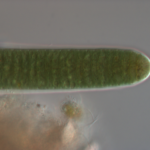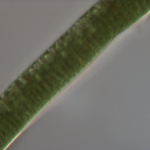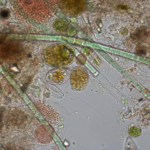Detected Species
-
HAB Species
- Diatoms
- Dinoflagellates
- Cyanobacteria
- Raphidophytes
- Haptophytes
-
Non-toxic Species
- Diatoms
- Dinoflagellates
Contact Us:
Mihaela D. Enache, Ph.D., Project Manager & Co-PI, Research Scientist I, Division of Science and Research, NJDEP (mihaela.enache@dep.nj.gov)
Ling Ren, Ph.D., PI, Research Assistant Professor, College of Science, George Mason University (lren2@gmu.edu)
Lyngbya aestuarii
Possibly Lyngbya majuscula
Morphology
Filaments unbranched with mucilaginous and sometimes laminated sheaths. Trichomes about 15-20 µm wide. Cells not constricted, short and discoid, about 2-5 µm long, shorter than wide. It is morphologically very similar to Lyngbya majuscula, a marine cyanobacterial harmful alga. The latter form hair-like colonies, which were not observed in this study.
Toxins and toxicity
Previous study showed toxin production, including Neosaxitoxin, Cryptophycin C, and Dudawalamide B, as well as microcystins, and impairment to reproductivity in mice (Kata et al., 2019). Lyngbya majuscula produces a large range of toxins (Lassus et al., 2016).
Distribution and Occurrence
Marine intertidal habitat, often forming mats. In this study, Lyngyba species were abundant in OMWM ponds in June and July. Relatively low abundance also observed in colder months (e.g., November-December).
References
Kata, F. S., E. Y. A. Al-Sultan, and A. M. Eassa. 2019. Toxicological investigation of a bloom of the blue – green alga Lyngbya aestuarii in Basra Governorate Southern of Iraq. International Journal of Biosciences. doi:10.12692/ijb/15.1.66-79
Lassus P.; N. Chomérat, P. Hess, and E. Nézan. 2016. Toxic and Harmful Microalgae of the World Ocean / Micro-algues toxiques et nuisibles de l’ocean mondial. Denmark, International Society for the Study of Harmful Algae / Intergovernmental Oceanographic Commission of UNESCO. IOC Manuals and Guides, 68. (Bilingual English/French).



